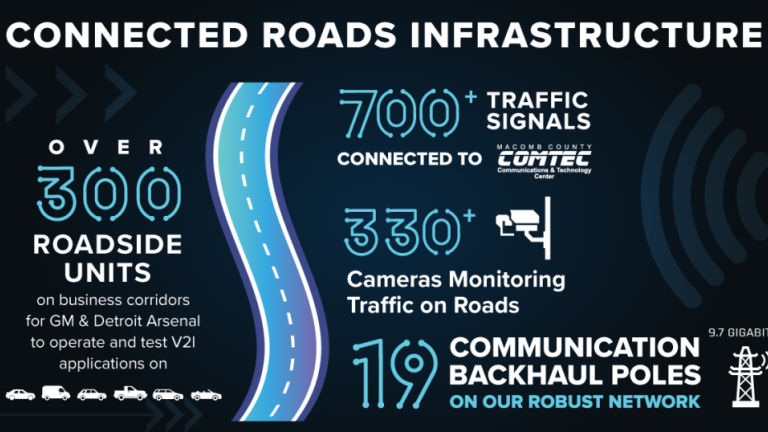The Detroit Auto Show is renowned for its fleet of future-focused vehicles. From concept cars to CAD drawings, the ideas for mobility seem endless – as is the discussion around what’s next for drivers. But topics that are sometimes missing from the conversation are our roadways and intelligent transportation systems (ITS). And those are important issues to explore, because smart cars won’t be very smart without smart roads and infrastructure.
Here in Macomb County, that’s not an issue. In fact, we’re leading the nation as one of the counties developing next-generation mobility strategies and roadways.
- We have more than 300 Roadside Units (RSU) on business corridors throughout the county.
- There are more than 700 traffic signals connected to COMTEC, the Macomb County Communications and Technology Center.
- 330+ cameras help that facility monitor traffic on roads and 19 communication backhaul poles have created a robust ITS network.
Why does this all matter? The first answer is safety. Ultimately, Macomb County would like to increase driver welfare on area roads and decrease the number of car accidents. By combining current traffic safety programs with vehicle-to-infrastructure (V2I) systems and vehicle-to-vehicle (V2V) communications, this goal is within reach. For instance, in a one-year period, the county experienced a 33% reduction in traffic crash-related fatalities. This is a direct result of actions taken by the Macomb Department of Roads backed up by data and technology.
The second answer is connected vehicle testing, an essential tool for the Big Three as they look to prototype and build more smart cars. To do that, they need infrastructure where they can assess their new vehicles in real-world settings. The 300 RSUs on Macomb’s business corridor give them this ability. These boxes gather and broadcast information at intersections and link with the connected vehicles to alert them to changing lights or other hazards. Eventually, the RSUs will be able to give speed guidance or construction alerts. And in the future, RSUs and connected vehicles could even communicate with other modes of transportation, like buses, pedestrians and bicycles, all using the same technology. But today, this system helps companies like GM, Ford and Stellantis experiment with their vehicles. And because Macomb prioritizes smart infrastructure, they can determine what will work and what won’t for drivers around the world. That’s certainly impressive; but of course, it makes sense that our region would be a trailblazer in this effort. We make the cars, therefore we lead the way in next-generation mobility.
Megan Ochmanek is a senior communications specialist for the Macomb County Department of Planning and Economic Development.







